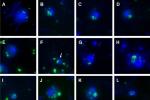Genus Limnohabitans - an important freshwater bacterial group serves as a model for testing responses of natural flagellate communities to different bacterial food quality
Interactions between bacterial prey and their predators in freshwater ecosystems are highly complex: For instance, prey-selective grazing of small heterotrophic flagellates on bacteria was found to have significant effects on bacterioplankton community composition. Considerably much less is known about impacts of bacterioplankton community composition ("potential prey food quality effects") on the predator community composition. Notably, different bacterial strains can have different nutritional value as food for flagellates, thus modulating their growth and community composition and in turn also the overall carbon flow to higher trophic levels.
We proposed an innovative experimental design to examine the influence of prey food quality using four Limnohabitans strains (a key freshwater bacterioplankton group), one Polynucleobacter strain and one actinobacterial strain (Luna 2 cluster) on growth (growth rate, length of lag phase, and growth efficiency) and community composition of a natural flagellate community from a freshwater reservoir. Pyrosequencing of eukaryotic SSU rRNA amplicons was used to assess prey-related changes in flagellate community composition. All Limnohabitans and Polynucleobacter strains were ingested (Figs. 1A to 1J), which yielded significant flagellate community growth. In contrast, the actinobacterial strain did not support the predator growth while its abundance was decreasing and the prey cells were clearly detected in flagellate food vacuoles (Figs. 1K and 1L). Notably, even within the Limnohabitans strains we found significant prey-related differences in flagellate growth parameters, which could not be only related to size or shape of the bacterial prey.
Sequence data characterizing the flagellate communities showed also that not only very different strains but even closely related bacterial prey items induced highly significant differences in the resulting community composition of flagellates. Phylotypes from Chrysophyceae closely related to Pedospumella or Spumella-like subclusters D and E2 were most abundant bacterivorous flagellates rapidly reacting to addition of the bacterial prey of high food quality. Our experimental approaches could provide important insights regarding the question which bacterial strains are active in carbon transfer to the grazer food chain in a particular aquatic system, and which flagellate groups are the key players in the trophic transfer. To our knowledge, the recent study conducted in collaboration with colleagues from Austria, Germany and UK, is the first one clearly documenting strong prey-specific effects of even closely related bacteria on flagellate community composition. This is an ecological aspect that has been long under debate but without any direct evidence concerning natural flagellate assemblages.
Publication:
Šimek K, Kasalický V, Jezbera J, Horňák K, Nedoma J, Hahn MW, Bass D, Jost S, Boenigk J. 2013: Differential freshwater flagellate community response to bacterial food quality with a focus on Limnohabitans bacteria. ISME Journal 7(8): 1519-1530 ( IF = 8.951)
ISME Journals FREE access, Featured Article (August issue, 2013): http://www.nature.com/ismej/journal/v7/n8/pdf/ismej201357a.pdf















